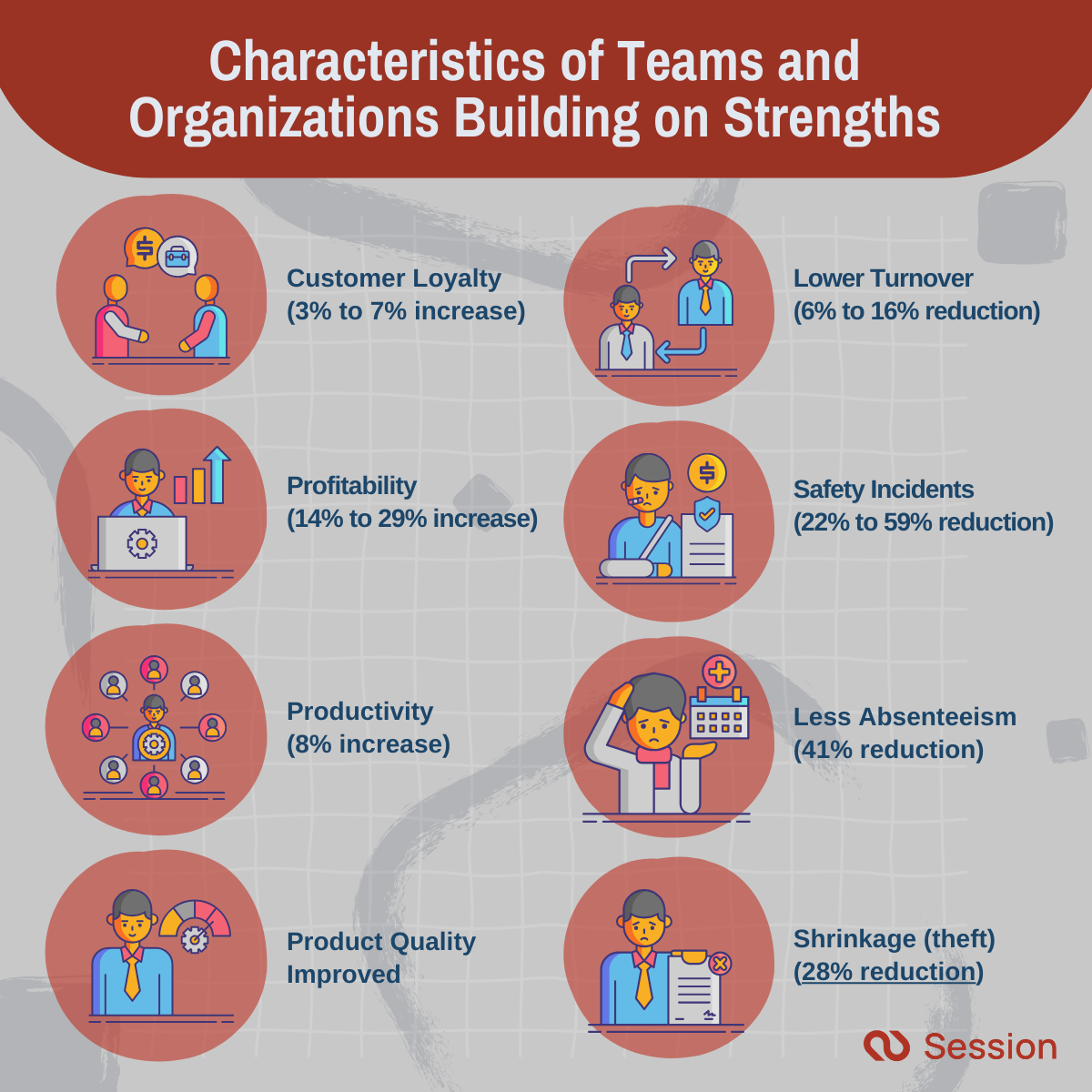Employees who play to their strengths every day are 15% less likely to quit, experience at least 22% fewer safety incidents and are 8% more productive. 8% doesn’t sound like much but is actually 20 days of extra productivity just for empowering employee strengths.
The main goal of strengths-based leadership is to identify and amplify employee- and team strengths whilst also dealing with weaknesses constructively. The result of such an approach is accelerated organizational success through optimized performance.
Strengths-Based Leadership, therefore, is both an individual approach, where managers bring theirs and their teams strengths into play, and an organizational approach, where leaders make sure the strengths of the business (i.e. the product,the unique culture of the company, market-position etc.) are leveraged effectively to fulfill the vision and mission.
In this article, we discuss the origins and philosophy of the strengths-based leadership approach before highlighting why it might be time your organization invested in leadership development and business coaching to actualise your team’s hidden potential.

The origins of the Strengths-Based leadership approach
Peter Drucker and the Task of Leadership
The first management book that paid real attention to strengths was the late Peter Drucker’s: “The Effective Executive”. Drucker grasped that to succeed, effective leaders must build on their own strengths and the strengths of their employees, superiors, customers, the organization, and the larger environment.
In one of the last interviews, he ever gave, Drucker offered his opinion on the prime task of leadership:
“The task of leadership is to create an alignment of strengths - making our weaknesses insignificant.”
This statement is the essence of Strengths-Based leadership. Our task is to align our own and our employee’s strengths in such a way that our weaknesses are no longer an obstacle to performance, efficiency, innovation, well-being, or growth.
David Cooperrider and Appreciative Inquiry
In the 1980s, the strength-based approach gained further traction with Professor David Cooperrider of the Weatherhead School of Management, Ohio/US.
Dr. Cooperrider developed an organizational framework: Appreciative Inquiry (AI). AI provides a standardized approach to identifying what works in society, organization, people, and teams - and amplifying those strengths. As Dr. Cooperrider describes it:
“AI is a systematic discovery of what gives “life” to a living system” when it is most effective.”
With its structured and simple method for organizational development, Appreciative Inquiry has proven its capacity for generating impressive results for solving complex social and environmental problems around the world. Similarly, it has been leveraged in businesses to restructure organizations and adjust vision and strategy implementation. On a smaller scale, business leaders use it to improve dialogue, enhance communication, and increase understanding internally and externally. Dr. Cooperrider's Appreciative Inquiry model emulates and mobilizes the message Drucker championed:
“It is more effective and healthier to focus on strengths and on what works than to focus on weaknesses and what does not work in order for the company to succeed on a broader scale.”
Since the “invention” of Appreciative Inquiry, the approach has been developed and expanded. It has grown to create a movement involving thousands of leaders and organizations all over the world. With the “Business as an Agent of World Benefit” (BAWB) movement, the approach has been taken to the next level, letting the strengths-based paradigm lead the way for organizations striving to create sustainable solutions for a better world.
Martin Seligman and Positive Psychology
As the Appreciative Inquiry movement picked up momentum into the 90s, it was ably supported by a new psychologically oriented movement headed by former American Psychological Association President, Martin Seligman. As part of their APA presidential manifestos, candidates pick themes that warrant attention during their presidency. Seligman chose positive psychology.
At the time, it was a rather unknown branch of psychology. But Seligman was fascinated by what brings out the best in people. What makes us thrive and overcome troubling times? What makes us happy, resilient, and filled with hope and optimism? His election liberated the field of psychological research from a tradition of focusing only on what makes us sick, unhealthy, and unhappy to becoming a tradition also focusing on what makes us healthy, happy and strong. American psychologists began to develop an understanding of what is right with people and their surroundings. They began to ask the question: “How can we generate happiness and strength?”
Seligman kick-started a series of research studies that have thus far proved that:
“The leaders who are capable of triggering positive emotions such as hope, optimism, and resilience among their staff achieve superior results than the leaders that trigger anger, fear, and hostility. The leaders who think (or learn to think more) positively and who generally look for the things that work (what is right in and for the organization, the situation, and the employees), achieve superior results.”
David Cameron and Positive Organizational Scholarship (POS)
Seligman’s APA presidency laid the foundation for the importance of understanding business success stories and how they could be replicated.
“Positive deviances” research into organizational structures and the resultant “Positive Organizational Scholarship” (POS) movement explores businesses that excel in their field, achieve extraordinary results and thrive and perform above their (expected) level—sometimes against all odds. The emphasis is on identifying the positive things that happen in these organizations and the conditions that underscore their success.
The mantra of the POS movement is as follows:
“If we want to identify what creates success and extraordinary performance, it is wise to examine the cases in which it already occurs.”
That may seem obvious but there is hidden depth. Success, well-being, and progress are not simply the opposite of or the absence of negative factors. Positive and negative results are not characterized by opposite conditions and consequences. Their root causes are fundamentally different. Thus, we do not necessarily learn about success by studying failure and nor do we succeed as individuals or businesses only by avoiding it.
Focusing on positive factors is a special area that deserves greater attention in companies and in research, simply because we cannot conclude what it takes to succeed (as an individual or an organization) by stating “just do the opposite of what it takes to be a failure.”
Marcus Buckingham and the Strengths Revolution
One of the more recent additions to the strengths-based approach comes from England, where for the past 20 years, Marcus Buckingham has revolutionized the perceptions of performance, efficiency, and achievement of results through a focus on individual strengths.
Buckingham initially spent two decades of research conducted with colleagues at Gallup, studying excellence and co-creating the StrengthsFinder tool. Later he founded his own Coaching and Education firm, focusing on helping individuals bring their strengths to play at the workplace. He sheds a light on the benefits of this both to the individual as well as the organization. Marcus Buckingham's work has touched the lives of thousands of professionals, helping them bring the best out in themselves and busting some hard grown myths about what human development is all about.
The female revolution within the Strengths Based Paradigm
So far we’ve mentioned the founding fathers of the Strengths Based Paradigm: Peter Drucker, David Cooperrider, Martin Seligman and Marcus Buckingham. In recent years, however, a handful of strong women have added to the research behind the paradigm, with their research within abundance and happiness (the broaden-and-build theory), the Growth Mindset, Vulnerability (and it’s link to strong and daring leadership), Psychological Safety and Innovative & agile strategic leadership.
We are, of course, speaking about Barbara Fredrickson, Carol Dweck, Brene Brown, Amy Edmondson and Linda A. Hill. Their research is taking us to the next level when it comes to understanding the power of building on and applying strengths on the individual as well as organizational level.
Now, let's turn our attention to some of the research findings regarding the effects of focusing on strengths in the workplace.
Benefits for leaders and companies of building on strengths
At Gallup, researchers have carried out thousands of quantitative and qualitative studies of what generates efficiency, high performance, and results in organizations. Here is what Gallup finds:
“The highest levels of performance and accomplishments co-occurring with the highest levels of well-being, employee satisfaction and commitment are found where leaders take an interest in and support the employees’ ability to bring their strengths into play.”
Gallup’s latest meta-analysis comparison study of the link between employee engagement and performance captured insights from 112,312 business work units, 2,708,538 employees and 54 industries. They found that teams and organizations with high engagement scores showed a positive correlation to success in the following business metrics:
Teams and organizations with high engagement scores have a higher:
- Customer loyalty (3 to 7% increase relative to high engagement)
- Profitability (14 to 29% increase)
- Productivity (sales, production records and evaluations) (8% increase)
- Product quality
And a lower:
- Lower turnover (6 to 16% reduction)
- Safety incidents (22 to 59% reduction)
- Less absenteeism (41% reduction)
- Shrinkage (theft) (28% reduction)
To further strengthen the case of the benefits of using a strengths-based approach to the development of individuals and organizations, The British Center for Applied Positive Psychology (CAPP) summarizes:
Benefits for leaders and companies of building on strengths:
- Putting untapped talent to use throughout the organization
- Better recruitment and retention of key employees
- Improved individual performance
- Higher engagement
- Development of flexibility among employees and between divisions
- Improved teamwork
- A positive emphasis on differences/diversity
- Greater openness to change
- Better handling of dismissals
- Enhanced job satisfaction
The Ideal Pit - the Philosophy behind Strengths Based Leadership
In a nutshell, the Strengths-based leadership approach rests on a philosophy—the Ideal Pit. The ideal pit is the overarching perspective that steers a strengths-based leadership style. It infuses positivity to create constructive 1:1s, develop the team, craft strategies, follow up on employee engagement surveys, etc.
The ideal pit is the ideal way of implementing the strengths-based paradigm and encouraging the desired effects to flourish (heightened engagement, productivity, wellbeing, thriving, etc.).
The Ideal Pit - Overview
I - Illuminate/shed light on what you want more of
D - Develop the strengths; compensate the weaknesses
E - Experiment, learn, modify
A - Accept what is and be authentic
L - Look for good intentions, reasons, and explanations
P - Positivity matters
I - Involvement is key
T - Timing and Presence is paramount
Application of Strengths Based Leadership
Every leader and employee is born with a certain amount of skepticism and critical thinking. This has helped us survive for generations. However, the conditioning to think critically for problem-solving and be aware of possible threats has limited our ability to apply the “Ideal Pit”. Most of us need to train ourselves to think in collaboration, teamwork, positivity, best intentions, and to shed light on what we need more of - not just what we need to avoid.
To lead from a strengths-based perspective, we need to establish a culture and structure in which everybody can bring their strengths into play, can make decisions quickly and independently, can be innovative and creative, can help one another, and can think and act for the benefit of the whole system. You may ask yourself: Do the structures and culture of my organization hinder or foster these elements? Does our collective leadership style hold us back? If your culture is not in accordance with the ideal pit, what can we do about it?
Leaders who want to establish a strengths-based culture can benefit from turning to professional business coaches. The coaching environment supports leaders to experiment with delegating, empowering, asking more questions, being curious and recognizing strengths in the individual, the team, and the organization.
Together, whole leadership teams can help bring their own, their team-members, their teams and the organization’s strengths to play. By developing themselves, together, from the perspective of strengths, they can help bring the organization to the next level of engagement, happiness and productivity.
At Session, we have highly skilled business coaches and consultants, ready to help upskill your employees and leaders in applying strengths-based leadership and collaboration. Reach out if you would like to learn more.













